The 2013 MacBook Air Review (11-inch)
by Vivek Gowri on August 9, 2013 1:45 AM ESTThe performance story is a bit interesting. There are two sets of 15W Haswell ULT parts, some with HD 4400 (GT2) and others with HD 5000 (GT3) onboard graphics. The GT3 parts, in order to hit the same TDP, run lower clock speeds. Apple chose to go for GT3 across the board. This isn’t the first time that Apple has made the decision to sacrifice CPU performance for the sake of GPU, but this was probably a pretty easy choice for them compared to 2010, when they skipped Arrandale on the 13” MacBook Pro and Airs for Penryn-era Core 2 Duo and Nvidia’s G 320M. That particular IGP was pretty fast, so much so that the substantially improved HD 3000 that came with the Sandy Bridge mobile parts was actually a bit of a downgrade on them.
The CPU tradeoff here is substantially less than it has been in the past, so this is a bit of a no-brainer. The i5-4250U in the base 2013 MacBook Air is clocked at a low 1.3GHz but has the same 2.6/2.3GHz (single core/dual core) turbo clocks as the 1.6GHz i5-4200U with GT2 graphics. The clock speed difference is even less at the high end: the optional i7-4650U is clocked at 1.7GHz and turbos to 3.3/2.9GHz while the fastest GT2 ULT part, the i7-4500U, runs 1.8/3.0/2.7GHz. The hit you take on base clock is pretty easy to justify for the more powerful GPU.
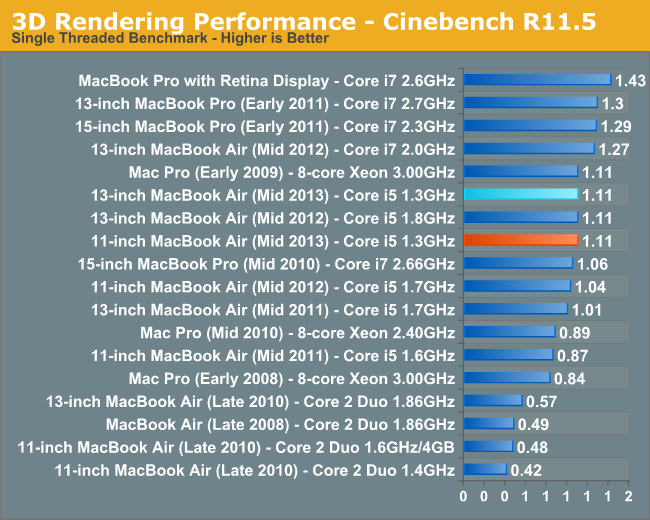
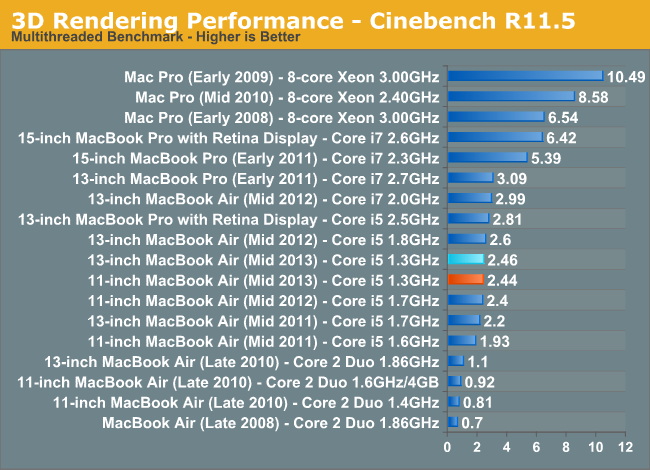 With that said, the raw performance isn’t really that great. The 13” Air that Anand reviewed was slower than its immediate predecessor, which used a 1.8GHz i5-3427U. The base 11” last year used an i5-3317U (1.7GHz) and that’s actually not a whole lot faster than the 11” Air I have here. The results are basically all within margin of error for the tests, so I’m content to call it basically even with last year’s model. The Air isn’t slow, but it can certainly get pokey at times. This is no different than any Ultrabook-class machine, but worth noting. Turbo and the very fast SSD keep things going smoothly in normal day-to-day tasks, but anything substantially more intensive than a browser and iTunes is going to be outside the comfort zone of a system like this.
With that said, the raw performance isn’t really that great. The 13” Air that Anand reviewed was slower than its immediate predecessor, which used a 1.8GHz i5-3427U. The base 11” last year used an i5-3317U (1.7GHz) and that’s actually not a whole lot faster than the 11” Air I have here. The results are basically all within margin of error for the tests, so I’m content to call it basically even with last year’s model. The Air isn’t slow, but it can certainly get pokey at times. This is no different than any Ultrabook-class machine, but worth noting. Turbo and the very fast SSD keep things going smoothly in normal day-to-day tasks, but anything substantially more intensive than a browser and iTunes is going to be outside the comfort zone of a system like this.
Considering the power efficiency though, getting similar performance to the old model even with 30% slower base clocks is a decent bargain, particularly when accounting for the increase in GPU and storage performance. I’m not going to go too far into those, since Anand did a really deep dive in his 13” Air review. It’s worth noting that while his Air had a Samsung SSD, the supplier lottery churned out a SanDisk SSD in my unit. The switch to PCIe SSDs really does make itself felt in day to day use, particularly in sleep/wake situations, as well as when launching particularly large applications (that then crawl their way through the power-sipping i5 ULT). I honestly didn’t expect that, given how accustomed I’ve become to the responsiveness of fast SSDs in general, but it’s pretty important to the MacBook Air simply in terms of keeping the system feeling quick to the touch.
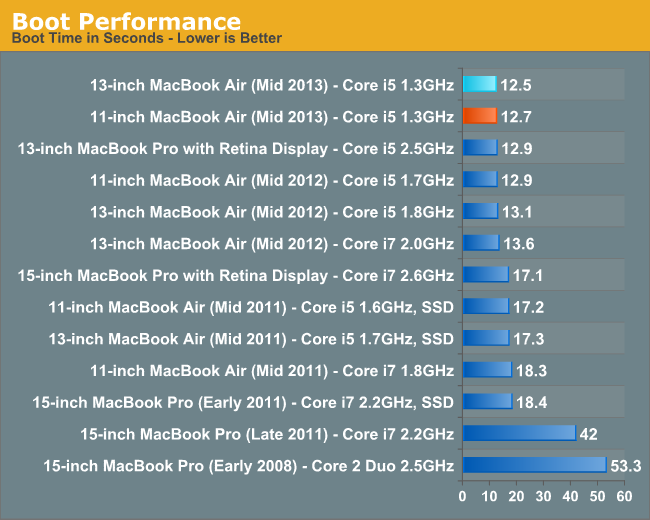

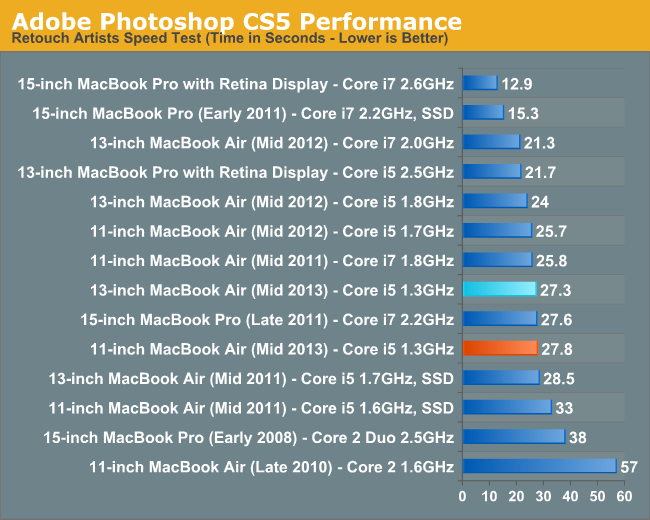


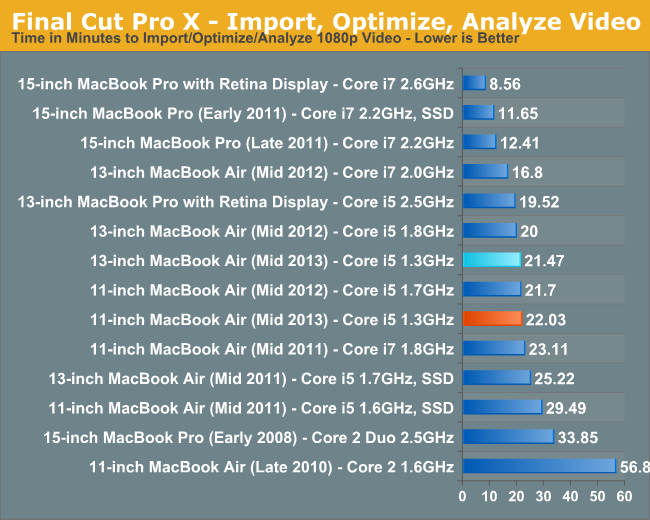










139 Comments
View All Comments
Torrijos - Friday, August 9, 2013 - link
One has to wonder how much more battery life improvements OS X Mavericks will bring, seeing how Apple made most of their selling points about energy efficiency.xTRICKYxx - Friday, August 9, 2013 - link
I've been using Mavericks for a while and I haven't noticed anything too drastic. I typically get around 7-8 hours of light workload for my 15". At most maybe a 10% increase.But this is not including the fact that most of my 3rd party apps do not include App Nap yet. It could make a difference.
ctrocks - Friday, August 9, 2013 - link
I still want to know the fascination with 11 inch notebooks. I am 6'3" (1.9m) tall, with relatively large hands, and am 47 with good vision for my age (no glasses needed yet). 13 inch notebooks seem small to me, let alone 11. My hands can't fit comfortably on keyboard to touch type.I understand portability, but I just can't see using such a small device except for cases where extreme portability is an absolute necessity. I would prefer a 15 inch screen, and a bigger keyboard that fits me over portability.
abazigal - Friday, August 9, 2013 - link
You just answered your own question. Ultra-portability. 15-inch laptops are great to use, but absolute murder to haul around when it's time to pack up and leave.ananduser - Friday, August 9, 2013 - link
Since you talked about the new Sony Vaio, how about, you know, actually reviewing one(the Pros or the Duo or both). You(Anandtech not Vivek) have reviewed 3 MBAs already and not a single other ultraportable.BTW corners have been cut in order to achieve the MBA's battery life, the low res screen and the relatively slower CPU. Why not mention it so as to compare apples to apples(no pun intended)?
fokka - Friday, August 9, 2013 - link
though i'm not a big fan of the mba, i still think that it is a valid choice for someone seeking portability and not dependent on a ton of processing performance, even more now the battery life has improved to a level you don't really have to think about it much anymore on a day to day basis.sure, the display is a bit of a bummer, but only because we became so spoiled by tablets and high-DPI laptops in the recent years. still, it won't hinder you doing any of your work.
what i like about the air and essentially the entire macbook line-up, is that they are no-nonsense solutions. you get a great package of high quality case, great input devices, above average display quality and most important usable battery life on a mobile device.
just compare it with the vaio pro. i love some of the vaio lineup for their performance, features and portability, but no way in hell i'm going to shell out this much for a plasticy-feeling computer, no matter if they call the material carbon fiber, magnesium, or whatever they come up with.
still, using a 2010 mbp13 right now, i'm not really thinking of investing in apple gear again very soon since i learned to prefer a more native windows environment. this is where asus zenbook line comes into play and i hope they can make similar progress with the haswell upgrade as apple, all while providing a great 1080p display.
ESC2000 - Saturday, August 10, 2013 - link
So a plastic feel would stop you from an otherwise superior product? Thus is the same tired old argument always trotted out by Apple fans. They used it when the S4 came out with features that demolished the iphone 5. They've probably used it for every Samsung phone that has been released with that prole plastic.It is your business how you spend your money, but I but devices to perform tasks for me. If a physical feature is relevant to function (eg the air's unnecessarily large bezels take up precious screen real estate) then I care. But if the best device for me comes in plastic I don't care unless plastic will disrupt its functioning. I don't care whether other people think my device looks expensive. I don't care whether it feels 'plasticky' when I touch it. What is so terrible about plastic anyway?
I know this is a tired old argument. I should probably save this post in keep so I can just copy paste it every time someone tries to say metal is more premium. Apple did do a good marketing job on that one though.
fokka - Saturday, August 10, 2013 - link
i wouldn't even go so far as to call myself an apple fan, since the macbook is the only apple product i ever owned and i'm not having plans on upping that count in the future, but still, i can appreciate certain aspects, like the build quality, of their line up.see, in the end it's just personal preference. i for one wouldn't be happy with a "superior" machine hardware wise, if it feel plasticy and flimsy. and please don't tell me a VAIO lid doesn't feel flimsy. i can't comment specifically on the VAIO pro, but about every sony ultraportable i ever touched had a crazy thin display lid which twisted by mere looking at it, so i feel safe extrapolating from that.
if you are happy with a polycarbonate build that's great and i don't even mean this sarcastically, but for me, i want a device i use for hours to feel great and sturdy and i find this is more the case with a good metal build.
geok1ng - Friday, August 9, 2013 - link
U$1000 for a 768p TN panel. I do agree with the review: lets wait for the Surface Pro with Haswelll parts. Or get a real high end ultraportable with a real high end display, for the same price apple is asking for this airthingieabazigal - Friday, August 9, 2013 - link
Higher screen res typically comes at the expense of poorer battery life. Apple simply made a judgement call to prioritize battery life over everything else. I don't see that as an inherently bad thing.